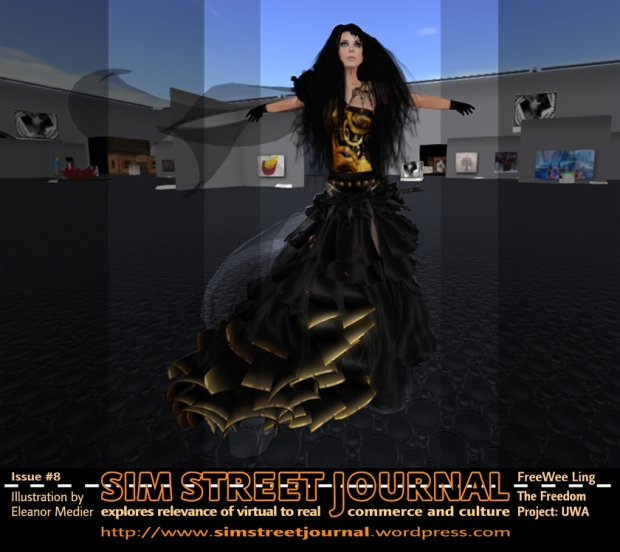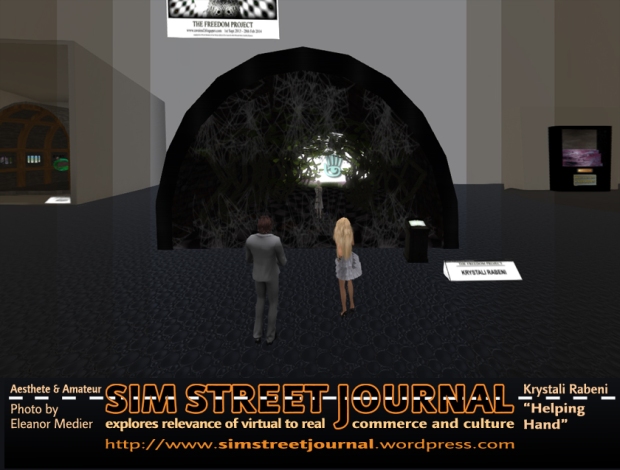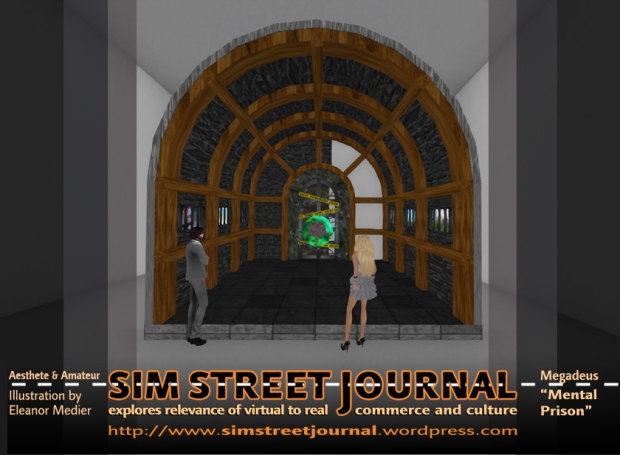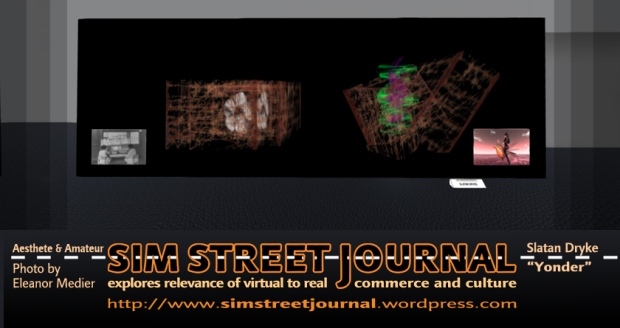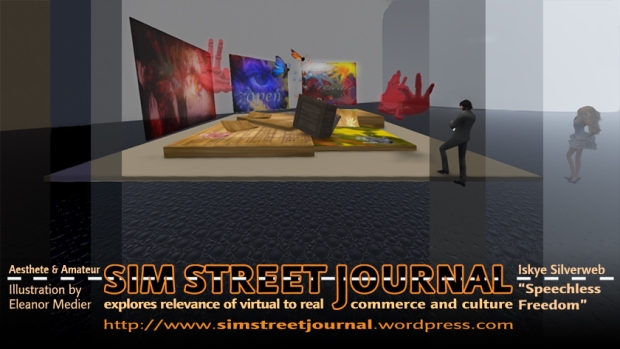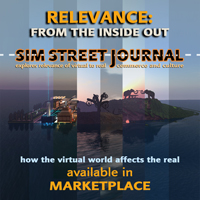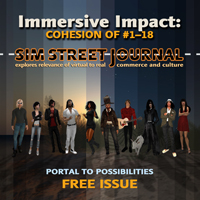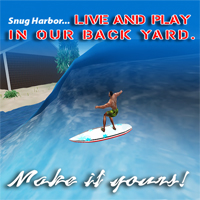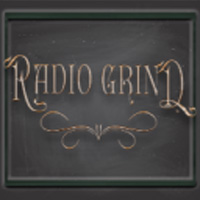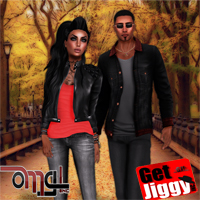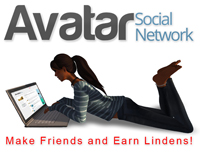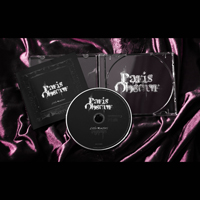Aesthete & Amateur 8, part 2: The Freedom Project
Fictitious on-going series (continued from Part 1) of gallery reviews by professional art critic, Eleanor Medier, and her less-than-professional (and proud of it) husband, Heavy Writer. (This review is not meant to declare which pieces are the best, but instead, are the most discussable. There are many works which dazzle in this show, and congratulations go to all the artists who participated.)
The Aesthete & the Amateur, SSJ #8, Part 2 (Part 3 in-world, and in thePDF: sim street journal #8) have reviews of works by:
– Traskin Snakeankle, “Lifeline”
– Ama Avro, “Passage”
– ParkArt Collaborative, “Freedom”
– Talia Sunsong, “Freedom Flight”
Online only are reviews (below) of:
– Krystali Rabeni, “Helping Hand”
– Megadeus, “Mental Prison”
– Slatan Dryke, “Yonder”
– Iskye Silverweb, “Speechless Freedom”
– – – – – – – – – – – – – – – – – –
Eleanor Medier dried her eyes over the copyright legalities and assumed her professional demeanor, while gathering husband Heavy Writer, to review The Freedom Project from the University of Western Australia, sponsored by The Virtual Ability Centre for ME/CFS, and Other Invisible Illnesses.
Eleanor had arranged to meet with the curator, FreeWee Ling, who was more than happy to dance while she discussed her impressions of the show. The first exhibit of its kind, The Freedom Project shows works by artists disabled in real life.
“There are a lot more people in SL with disabilities and chronic illnesses than most people might imagine. It seems a natural place to come and feel empowered. Several of the artists in this show are brilliant established artists we have known for a long time from previous shows, but I had no idea about their personal lives. And I had no idea what to expect. I was surprised to learn about some. And I am delighted that they are willing to share themselves. In many cases the act of putting their work in a public show was very difficult for them. I admire the courage of all our artists. The show is an unequivocal success on all levels. Including purely as an art exhibit.” —FreeWee Ling
Heavy: “I must admit I’m pleasantly surprised with this exhibit—the artists really got the theme serious, they understood the theme.”
Eleanor: “I know many disabled people in SL that are smart and talented. I know there is a high percentage of disabled here.”
Heavy: “Though they might be all focused on same idea, at first glance, it seems there are so many different interpretations!”
Eleanor: “It is expected that they will find real life more constricting. Virtual reality opens new choices. You can duplicate or mirror reality if you want— it is an idealization though.”
Heavy: “You need fantasy to be in SL; you need an open mind.”
“Helping Hand” by Krystali Rabeni
Heavy: “Check this out dear—this has a similar theme to the first piece we discussed (Lifeline by Traskin Snakeankle (see review in SSJ in-world))— again SL comes to the rescue. This is more obvious.”
Eleanor: “I expect this theme, really. This interpretation is that SL is the “helping hand.”
Heavy: “See, the person here is in woods—a dark wood—but the SL sign gives light.”
Eleanor: “Yes, but that SL logo almost looks like a shrine—even religious. It seems too visually dominant for the sensitivity of the rest, which is very well depicted. There are cobwebs, it is all murky, and the figure is immersed. But that logo looks too much like The Light at the End of the Tunnel. The balance feels off because the logo dominates so much over the beauty in the rest. Also, here we find the artist invites us to read her Diary as part of the piece.”
Heavy clicks on the sign and opens the file: “This is tough reading.”
Eleanor: “Yet it is self-nurturing, with very sad realizations and a challenge to acceptance.”
Heavy: “I can’t even imagine with what these people have to deal with. We must be kind with them ….”
Eleanor: “She knows what her reality is, and knows that she has some escape too. I have expected all of these artists to express the freedom of being in SL. However, freedom comes with a price, always, and I have yet to see anyone approach the flip side.”
“Mental Prison” by Megadeus
Heavy: “This is a little harder to understand, but is another literal statement.”
Eleanor: “What is in the middle there? A brain in that green globe??”
Heavy: “That brain (person) is using a tool to break the locks of that door. The brain is in a cell now, but if you look through the cell windows, you’ll see the other side is virtual again.”
Eleanor: “See the yellow police tape on the door in the back??”
Heavy: “Yes, is like saying ‘Do not enter.’”
Eleanor: “This, again, says that the virtual life is the free life, and the real life is a prison. I am sure that disabled people feel trapped in their real life limitations.”
Heavy: “It is also about how many people are trapped in real life and don’t even consider the virtual experience.”
Eleanor: “Lets face it: we all have more freedom in the virtual worlds, but these artists have a disadvantage in real life that we abled people don’t have. I think they are super lucky to have this experience.”
Heavy: “See, the fact we have just a brain, and not an entire person, tells us the brain is in good condition but body isn’t.”
Eleanor: “The green is a nurturing color.”
Heavy: “The brain wants to evade the body, so it goes into virtual space to find another body—in the virtual, we have another body, our avatars.”
Eleanor: “Well that is true—here we get other bodies. The brain wants its own space within the limitations. This prison though, doesn’t look so threatening—it seems to be a fairly uneventful place except for the tape on the door in the back.”
Heavy: “It is a medieval cell. Even if is not threatening, it is cold with all that stone. And a cell is a cell—nothing pleasant about a cell. For people who can be walking on a death road, reality is threatening because they don’t have a cure for their sickness. But there are also people who have been born disabled or they have become so do to an accident.”
Eleanor: “It is still not easy to be here either; it does take a lot of energy to build and exhibit.”
Heavy: “For them reality is not threatening but is just a jail cell. See the difference?”
Eleanor: “In the first pieces we discussed, I did find the statement that reality is threatening.”
Heavy: “Considering on how that wood looks like a cave that can always hide a monster.”
Eleanor: “The thing is, virtual worlds are not just a walk in the park.”
Heavy: “This cell here for example wont tell much in a magazine page because you need to be immersed to really understand.”
Eleanor: “This one is harder to portray, but very intriguing.”
“Yonder” by Slatan Dryke
Eleanor: “It seems natural for an ill person to wish to be somewhere else.”
Heavy: “Speaking about wishing to be in another place, SL offers that to ill people—they have an escape now. And I have many friends that have found freedom, and even happiness, here.”
Eleanor: “Well, the escape aspect can be good for ill people, but bad for addicted people. It is a double edged sword.”
Heavy: “Real life is the same—any abuse in real life can be deadly too. This piece has four sections. I think they are paired—two pairs.”
Eleanor: “Again we find smaller screens with virtual world slide show stills. But the two large shapes are abstract, cage-like because there is something trapped inside. They are more slowly animated. This one also presents the virtual world as 2D screens, and the abstract shapes are 3D.”
Heavy: “In real life is all black and white; in SL, it gets color.”
Eleanor: “Here is a question: if we did not know the theme of the show, would we interpret this piece differently?? So this shows a black and white flat flower encaged, and a fast-animated form that changes colors, also encaged.”
Heavy: “The animated form is shaking the cage. Look closely—the cage lost its perfect shape. Look from a little distance and you’ll see that colorful vortex is shaking one piece of the cage, and the cage is no longer a perfect cube.”
Eleanor: “Might the colorful vortex form be rebellious? Lively in an environment where nothing else is?? Like an active mind trapped? Sometimes the vortex looks like flames, but it changes colors and nothing else does either.”
Heavy: “Because no matter how much imagination we have and how much freedom we can get using our imagination, we are still prisoners of our bodies. We live as long our body is fed, as long our brain gets sleep, and so on. So imagination is forcing the borders—not easy thing to do.”
Eleanor: “What keeps my eyes in this piece is that changing vortex. I am most intrigued watching it and not the changing slide show.”
Heavy: “The slide shows are not really need it for this piece, considering the theme of the exhibit we would have been figured without slide shows.”
Eleanor: “And the big shapes are more fascinating to watch.”
“Speechless Freedom” by Iskye Silverweb
Eleanor: “This animation is odd. Why do those hands move versus anything else?”
Heavy: “’Dream Open Release.’ He needs these words. I have to look at those first.”
Eleanor: “It is the movement that first catches my eye. I always find it curious what is chosen to animate.”
Heavy: “This is about creation: Dream—have an idea. Open—accept and start developing that idea. Release—share your idea.”
Eleanor: “Development. This piece has a lot of elements.”
Heavy: “It is freedom of mind again.”
Eleanor: “It seems to be forms of creativity— the books on the floor, the transformative butterflies again. We are seeing a lot of butterflies in this show.”
Heavy: “Lol—those are not books. They are SL scripts in development. Have you tried to read those scrolls? It is scripting language.”
Eleanor: “The butterfly gains abilities. Maybe they wish for that. Do you think butterflies are too obvious a symbol??”
Heavy: “I accept the symbol. They evolve. If by having butterflies means being different than the masses, I want having butterflies too. :)”
Eleanor: “Well, this looks like some fairly obvious symbolism— a box, some manuscripts, books, hands, eyes. My big question here is, what does the animation do to enhance this piece?? They confuse me. The butterflies have direction. But these hands aren’t changing anything.”
Heavy: “If you look inside box are just eggs—then they evolve into those big butterflies.”
Eleanor: “Hard to tell what those shapes are in the box.”
Heavy: “These hands mimic of the words on boards—afterall is called Speechless. But since the artist uses words, the title doesn’t fit. DREAM-OPEN-RELEASE kills the title that is Speechless Freedom.’”
Eleanor: “Do you mean a contradiction? I am trying to connect these various symbols.”
Heavy: “The concept is even obvious, just the title doesn’t fit.”
Eleanor: “I don’t know why the hands move, and I don’t know why there are two round shapes in the box. Maybe those are ideas?”
Heavy waves his hands: “The hands moving means hocus pocus—voila! Another great idea released! You got it now?”
Eleanor: “Like a magic show— like ideas are magic?”
Heavy: “When the artists are together they work on something. Once work is done they share to the world, they open, like releasing one butterfly after another.”
Eleanor: “They are identical, which makes me think it is only one person’s hands.”
Heavy: ““Would you have preferred to have 100 pairs of hands moving? These 2 already made me dizzy. It is a symbol.”
Eleanor: I would prefer the hands do more here, rather than just move back and forth.”
Heavy: “Then author needs better scripts—a work in progress I’m sure somewhere on the grid.”
Eleanor: “Perhaps this is like a studio of one person’s creativity??”
– – – – – – – – – – – – – – – – – – – – – – – – – – – – – – – – – – – – – – – – – – – – –
Advertising Opportunities
Sim Street Journal also supports several events:
ASN Photo Contest
UWA’s Freedom Project
Rose Theatre and Galleries
Book Island
– – – – – – – – – – – – – – – – – – – – – – – – – – – – – – – – – – – – – – – – – – – – –
PLEASE SEE THE IN-WORLD SPONSORS FOR SIM STREET JOURNAL #8
Enjoy different, but related, issue versions: online and in-world (available at the Second Life® SSJ office (Innu 40, 36, 1650) or here as a PDF: sim street journal #8.
Back issues are available on MARKETPLACE).
Contributions are encouraged if covering topics relevant to the real world readers.
– – – – – – – – – – – – – CONTACTS:
Sim Street Journal explores the relevance of virtual to real commerce and culture.
ONLINE: https://simstreetjournal.wordpress.com/
FACEBOOK: https://www.facebook.com/simstreetjournal
IN-WORLD: http://maps.secondlife.com/secondlife/Innu/40/36/1650
MARKETPLACE: https://marketplace.secondlife.com/stores/148961
EMAIL: simstreetjournal@gmail.com
Sim Street Journal explores the relevance of second to first life.
© 2014 by Eleanor Medier, Sim Street Journal. Articles cannot be reprinted without permission.
